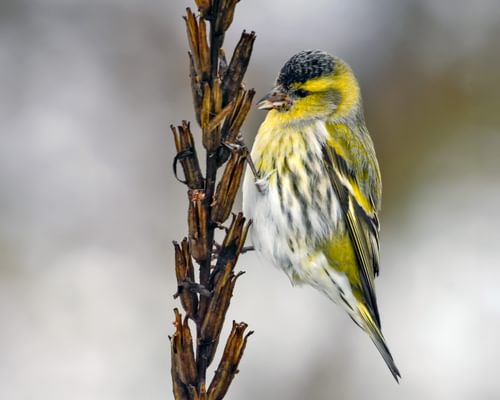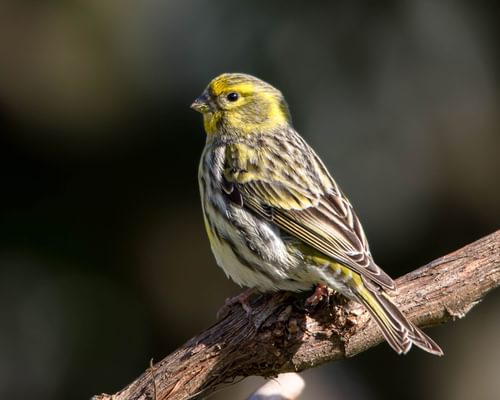Greenfinch
Least ConcernChloris chloris
Visual Identification
Appearance
The Greenfinch is a robust, small finch with distinctive olive-green plumage. Males display brighter yellow-green hues on their breast and rump, with striking yellow patches on their wings and tail. The stout cone-shaped, pale pink beak is a key identifying feature.
Females are duller and have little to no green plumage, with more brown tones and less yellow. Both sexes have pinkish legs and small dark eyes.
Juveniles resemble females but have streaked underparts. Winter plumage in both sexes is slightly duller than breeding plumage.
Size
Length
14cm to 16cm
Wingspan
24cm to 28cm
Weight
25g to 35g
Habitat and Distribution
Habitats
Woodland
Garden
Wetland
Coastal
Urban
Farmland
Grassland
Desert
Tundra
Rainforest
Mountain
Savanna
Distribution
Greenfinches inhabit a wide range of habitats, including woodlands, gardens, parks, and farmland across Europe, North Africa, and parts of Asia. They prefer areas with a mix of trees and open spaces for foraging.
In the UK, they are widespread residents, while in northern parts of their range, some populations migrate south for winter. They have also been introduced to Australia and New Zealand, where they have established successful populations.
Elevation Range
Up to 2,000 meters
Climate zones
Temperate, Mediterranean
Distribution Map
This map gives you a rough idea of where you might spot a Greenfinch. The coloured areas show countries where these birds have been seen.
A few things to keep in mind:
- Birds might not be everywhere in the coloured areas, for example, they may be present around the coast of that country
- Where birds live can change with seasons and available food
- This map is quite simple - it doesn't show exact locations
We're working on making our maps even better! Soon, we hope to show you:
- More detailed maps for bigger countries, including state and region
- How birds move around during different seasons
Distribution by Region
Behaviour and Ecology
Bird Attributes
This feature is in beta. We'd love your feedback to improve it!
Share your thoughtsBird Attributes Explained
Our bird attributes system rates various aspects of a bird's capabilities on a scale of 0-100, based on data from field observations, scientific studies, and expert knowledge.
Attribute Categories:
- Agility: Manoeuvrability, speed, and grace in flight or movement.
- Strength: Physical power, often correlating with size and hunting abilities.
- Adaptability: Ability to thrive in various environments or changing conditions.
- Aggressiveness: Territorial behaviour and assertiveness, particularly during breeding seasons.
- Endurance: Stamina, often seen in migration patterns or foraging behaviours.
Understanding the Ratings:
- 0-20: Very Low
- 21-40: Low
- 41-60: Average
- 61-80: High
- 81-100: Very High
Remember, these attributes are relative to other bird species and don't necessarily indicate superiority.
Hover over the icon next to each attribute for more information.
Tap the icon next to each attribute for more information.
Agility
Reflects the bird's manoeuvrability, speed, and grace in flight or movement.
The Greenfinch displays considerable agility, particularly in its acrobatic feeding habits. Their ability to hang upside down on feeders and perform elaborate flight displays during courtship demonstrates a high level of manoeuvrability and aerial skill.
Strength
Indicates the bird's physical power, often correlating with size and hunting abilities.
Whilst not exceptionally strong for their size, Greenfinches possess robust beaks capable of cracking open tough seeds that smaller finches cannot manage. This indicates a respectable level of strength, particularly in their jaw muscles.
Adaptability
Represents the bird's ability to thrive in various environments or changing conditions.
Greenfinches show good adaptability, thriving in various habitats from woodlands to urban gardens. Their ability to adjust their diet based on availability and to successfully colonise new areas (as seen in New Zealand) suggests a strong capacity for adaptation.
Aggressiveness
Measures the bird's territorial behaviour and assertiveness, particularly during breeding seasons.
Greenfinches are generally social birds, often seen in flocks outside the breeding season. However, they may display some territorial behaviour during breeding. Their aggression level is moderate, primarily limited to competitive interactions at feeding sites or during mating season.
Endurance
Reflects the bird's stamina, often seen in migration patterns or foraging behaviours.
As partial migrants capable of long-distance flights and with the ability to raise multiple broods in a season, Greenfinches demonstrate decent endurance. However, their relatively short lifespan (2-3 years on average) and vulnerability to diseases like trichomonosis suggest limitations in their overall endurance.
Diet
Greenfinches primarily feed on seeds, with a particular fondness for sunflower seeds and other large seeds. They also consume buds, berries, and insects, especially when feeding their young. Their strong beaks allow them to crack open tough seeds that smaller finches cannot manage.
These birds forage everywhere, from the ground to upper tree branches, for seeds, flowers, buds, and fruits of many plant species, including bramble, yew, and rosehip.
Behaviour
Greenfinches are social birds, often seen in small flocks outside the breeding season. They have a distinctive undulating flight pattern and are known for their acrobatic feeding habits, often hanging upside down on feeders. During courtship, males perform elaborate flight displays, soaring and gliding to attract females.
Vocalisation
The Greenfinch's song is a mix of trills and twitters, often ending with a distinctive wheezing 'dzweee' sound. Their call is a sharp 'tswee' or 'tswit'. During flight, they make a characteristic 'chichichichichi' sound.
Males sing more frequently during the breeding season, often from prominent perches or during display flight. Listen out for this pleasant but disjointed song from January to the end of summer and particularly from March to July.
Nesting & Breeding
Breeding season for Greenfinches typically begins in April. Males attract females with their song and flight displays, often chasing potential mates in flight. Pairs form monogamous bonds for the breeding season.
Nests are built by the female in shrubs or trees, usually 2-3 meters above ground. The nest is a neat cup made of twigs, moss, and grass, lined with fine roots and hair. The female lays 4-6 pale blue eggs with reddish-brown spots.
Incubation lasts about 13-14 days, and it is mainly performed by the female. Both parents feed the chicks, which fledge after 13-16 days. Greenfinches often raise two broods per season.
Lifespan
years
The Greenfinch typically lives for 2 to 3 years.
Like all birds, lifespan can be affected by factors including predation, habitat quality, disease, and access to food sources.
Conservation and Status
Global Conservation Status
While listed as Least Concern globally, Greenfinch populations in some areas, particularly the UK, have faced significant declines due to trichomonosis, a parasitic disease. Conservation efforts focus on garden hygiene, especially cleaning bird feeders regularly to prevent disease spread.
Birdwatching Tips
- Look for Greenfinches in gardens, parks, and woodland edges
- Listen for their distinctive wheezing call, often given from treetops
- Observe feeders, especially those with sunflower seeds
- Watch for their characteristic undulating flight pattern
- In the UK, participate in the RSPB's Big Garden Birdwatch to contribute to Greenfinch monitoring
Additional Information
Quick Facts
Other names:
European Greenfinch
Family:
FringillidaePredators
Main predators include domestic cats, sparrowhawks, and other birds of prey. Nests may be raided by magpies, jays, and squirrels.
Did You Know?
- Greenfinches can open their beaks with enough force to crack open tough seeds.
- They are one of the few finches that feed their young with regurgitated seeds rather than insects.
- In some areas, Greenfinches have learned to mimic the sounds of other birds, including alarm calls.
Was this bird profile helpful?
Your feedback helps us improve our content
Thanks for your feedback!
Your input helps us improve our content.
Community Experience
Community Ratings
No ratings yet - be the first to rate this bird!
Latest Community Reviews
No reviews yet
Sign in to be the first to review
Community Reviews
Create Your Free Account Welcome Back!
Join our community to rate birds and share your experiences. Creating an account is completely free and only takes a minute. Sign in to your account to rate birds and share your experiences with our community.
Your information is secure and will never be shared.
By creating an account, you agree to our Privacy Policy.
FAQs
How do I attract Greenfinches to my garden?
Greenfinches are regular visitors to garden bird feeders, where they relish sunflower seeds and peanuts. You can also attract these boisterous back-garden birds by setting up a birdbath or other shallow water features for drinking and bathing.
Similar Birds
References
- 1 2
website: BirdLife International. 2018. Chloris chloris. The IUCN Red List of Threatened Species 2018: e.T22720330A132000123.
View source - 3
report, 2015: EBCC

